Rothe House
Rothe House /ˈroʊθ/ is a late 16th-century merchant's townhouse complex located in the city of Kilkenny.[1] The complex was built by John Rothe Fitz-Piers between 1594–1610 and is made up of three houses, three enclosed courtyards, and a large reconstructed garden with orchard.[2]
| Rothe House | |
|---|---|
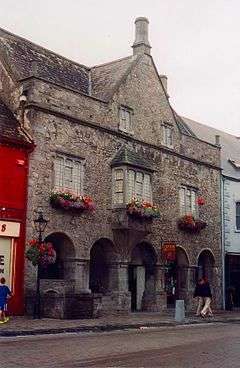 | |
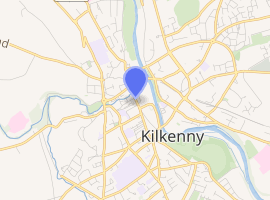
| |
| General information | |
| Type | Merchant townhouse |
| Architectural style | English Renaissance style |
| Address | Parliament Street |
| Town or city | Kilkenny |
| Country | Ireland |
| Coordinates | |
| Construction started | 1594 |
| Completed | 1610 |
| Owner | Kilkenny Archaeological Society |
| Website | |
| http://www.rothehouse.com/ | |
Rothe House is the only remaining example of its type in Ireland,[1] and considered to be nationally significant because of the range of original post-medieval features that survive.[3] The property, an important element of Kilkenny's heritage, is owned by the Kilkenny Archaeological Society and houses some of the society's collection of artefacts relating to Kilkenny City, County and Ireland.
The garden to the rear of the house has been reconstructed to reflect a typical 17th-century garden. The burgage plot on which Rothe House was built survives intact – one of a few in such an unaltered state. Kilkenny's medieval city wall forms part of the curtilage of the Rothe House complex.
History
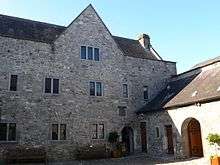
The Rothe family were merchants foremost, but also involved in politics. They were part of an oligarchy of around ten families who controlled Kilkenny throughout the 15th and 16th centuries, and into the 17th century. Rothe house was constructed on burgage plot John Rothe Fitz Piers acquired.
The house was confiscated after Charles I defeat in England, due to their involvement in the confederation of Kilkenny. Following the restoration of Charles II, the house was given back to the family.
Architecture
Rothe House is an example of a house owned by Kilkenny's merchant class. It was built in the English Renaissance style which was introduced to the south-east of Ireland by the Thomas Butler the 10th Earl of Ormond in the 1560s.[4]
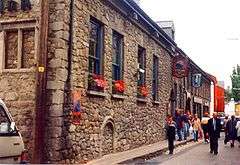
The configuration of the original consecutive building sequence of John Rothe's three houses (dating respectively to 1594, 1604 and 1610) has survived intact.[3] Rothe's sequential building programme is significant, as he deliberately built three independent houses rather than extending the first house to accommodate the needs of his growing family. In this, he followed the pattern of development chosen by his wife's family (the Archers) in their arrangement of the Archer house and the house built behind it, now known as 'The Hole in the Wall'.
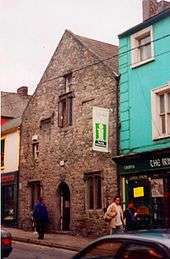
Houses in Kilkenny which survive from the same period as Rothe House are; 'The Hole in the Wall', High Street, built 1582-4 by the Archer family; Shee Alms House, Rose Inn Street built 1582 by the Shee family; The Bridge House, John Street built around the late 16th century which survives in part; Kyteler's Inn, St. Kieran's built 1473–1702 built by the Kyteler family; also Deanery, Coach Road in 1614 and 21 Parliament Street which was built in the late 16th/17th century and survives in part.
Statutory status

Rothe House is listed as an element of the urban area of Kilkenny City in the Record of Monuments and Places, it is listed in the Area of Archaeological Importance in the Urban Archaeological Survey County Kilkenny. It also is a nationally significant structure from the Planning Authority Development Plan under List 1 of the Kilkenny City and Environs Development Plan, 1994 and it is listed as being of national importance in the National Inventory of Architectural Heritage survey of Kilkenny.[3][5]
Museum
The museum at Rothe House contains a number of archaeological and historical artefacts, most of which were found locally or donated by citizens of Kilkenny to the Kilkenny Archaeological Society.[6]
Notes
- "Welcome To Rothe House Kilkenny". rothehouse.com. Archived from the original on 3 March 2016.
Rothe House & Garden, a historic house in Kilkenny [...] is the only example of an early 17th century merchant’s townhouse in Ireland.
- "Rothe House - History". rothehouse.com. Archived from the original on 3 March 2016.
- Ozmin 2002
- Murtagh 1998
- "Rothe House, 15-16 Parliament Street, Kilkenny, County Kilkenny". Buildings of Ireland. National Inventory of Architectural Heritage. Retrieved 22 February 2017.
- "Museum". rothehouse.com. Archived from the original on 4 March 2016.
Further reading
- Murtagh, B. (1998), "The New Building, an Eighteenth Century House, New Buildings Lane, Kilkenny", Old Kilkenny Review, Kilkenny Archaeological Society: 48–65
- Ó Drisceoil, Cóilín (2008), "The Rothe family garden rediscovered: An interim report on the 2007 archaeological excavation project", Old Kilkenny Review, No. 60, Kilkenny Archaeological SocietyCS1 maint: ref=harv (link)
- McQuillan, Róisín (2008), "The Rothe House family garden", Old Kilkenny Review, No. 60, Kilkenny Archaeological SocietyCS1 maint: ref=harv (link)
- Ozmin, Elizabeth (2002), Rothe House, Parliament Street, County Kilkenny, Conservation Plan. (PDF), Heritage CouncilCS1 maint: ref=harv (link)
External links
| Wikimedia Commons has media related to Rothe House. |